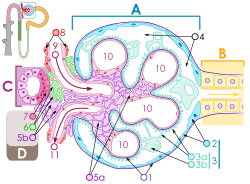Juxtaglomerular
| Juxtaglomerular apparatus | |
|---|---|

A renal corpuscle, the functional unit of the kidney, shown in blue and pink. The juxtaglomerular apparatus is shown to the left and labelled D.
|
|
| Identifiers | |
| FMA | 83599 |
|
Anatomical terminology
[]
|
|
The juxtaglomerular apparatus is a microscopic structure in the kidney that regulates the function of each nephron, the functional units of the kidney. The juxtaglomerular apparatus is named because it is next to (juxta-) the glomerulus.
The juxtaglomerular apparatus consists of three types of cells:
The juxtaglomerular apparatus is part of the kidney nephron, next to the glomerulus. It is found between where blood enters a renal corpuscle and the distal convoluted tubule of the same nephron. This location is critical to its function in regulating renal blood flow and glomerular filtration rate.
The juxtaglomerular apparatus consists of three cell types. These are:
Renin is produced by Juxtaglomerular cells. These cells are similar to epithelium and are located in the media of the afferent arterioles as they enter the glomeruli. The juxtaglomerular cells secrete renin in response to:
Extraglomerular mesangial cells are located in the junction between the afferent and efferent arterioles, but their significance in this location is unknown. Renin is also found in these cells.
At the point where the afferent arterioles enter the glomerulus and the efferent arteriole leaves it, the tubule of nephron touches the arterioles of the glomerulus from which it rose. At this location, thick ascending limb of loop of Henle, there is a modified region of tubular epithelium called the Macula densa. Cells in the macula densa respond to changes in the sodium chloride levels in the distal tubule of the nephron via the tubuloglomerular feedback (TGF) loop.
...
Wikipedia
